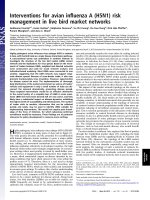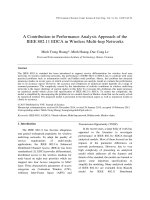Adaptive traffic distribution in optical burst switching networks
Bạn đang xem bản rút gọn của tài liệu. Xem và tải ngay bản đầy đủ của tài liệu tại đây (1.99 MB, 110 trang )
ADAPTIVE TRAFFIC DISTRIBUTION IN OPTICAL
BURST SWITCHING NETWORKS
LU JIA
(B.Eng.(Hons.), NUS)
A THESIS SUBMITTED
FOR THE DEGREE OF MASTER OF ENGINEERING
DEPARTMENT OF ELECTRICAL & COMPUTER ENGINEERING
NATIONAL UNIVERSITY OF SINGAPORE
2005
i
Acknowledgements
I would like to thank the following personnel for their invaluable advice and help
during the whole course of the project.
First and foremost, Dr Mohan Gurusamy and A/Prof Chua Kee Chaing, project
supervisors, for their invaluable guidance, advice and understanding throughout the
project.
Mr. Liu Yong, Research Fellow at the Optical Network Laboratory for his
helpful advice and in-depth discussions on the key issues related to my research
work.
I would also like to thank my parents for their love, care and encouragement
which have given me the courage to overcome the difficulties all along the way.
ii
Contents
ACKNOWLEDGEMENT…………………………………………… i
SUMMARY……………………………………………………………….iv
LIST OF TABLES…………………………………………………… vii
LIST OF FIGURES……………………………………………… viii
LIST OF ABREVIATIONS……….………………………………………x
CHAPTER 1 INTRODUCTION 1
1.1 Background in Optical Networking 1
1.2 Overview of Optical Burst Switching Technology 7
1.3 Contributions 12
CHAPTER 2 17RELATED WORK
2.1 Contention Problem in OBS Networks 17
2.1.1 Wavelength Channel Scheduling Algorithms 17
2.1.2 Contention Resolution Policies in OBS Networks 18
2.1.3 Contention Avoidance Policies in OBS Networks 19
2.2 Load Balancing and Multi-path Traffic Routing in IP/MPLS Networks 22
2.3 Load Balancing and Multi-path Traffic Routing in OBS Networks 24
CHAPTER 3
27
ADAPTIVE PROPORTIONAL FLOW ROUTING IN
IP-OVER-WDM OBS NETWORKS
3.1 Introduction 27
3.2 An Overview of the Proposed Adaptive Proportional Flow Routing
Algorithm 29
3.3 Adaptive Proportional Flow Routing Algorithm 32
3.3.1 Notations 32
3.3.2 Traffic Measurement 33
3.3.3 Flow Proportion Assignment 34
3.3.4 Traffic Flow Distribution 38
3.3.5 Burst Assembly Unit 40
3.4 Performance Study 42
iii
3.4.1 Identical Traffic Demand…… ……………………………………………46
3.4.1.1 Effect of Traffic Loading… …………………… ……… 46
3.4.1.2 Effect of Measuring Time Window Size…………………………… 49
3.4.1.3 Effect of Congestion Threshold Values………………………………….51
3.4.2 Adaptive Proportional Flow Routing Algorithm with Varying Burst Assembly
Time (APFRA-VBA)………………………………………….……………….53
3.4.3 Non-identical Traffic Demand 54
3.4.4 Performance of APFRA-VBA under Non-identical Traffic Demand 57
3.4.5 Summary of Results 58
CHAPTER 4 GRADIENT PROJECTION BASED MULTI-PATH
TRAFFIC ROUTING IN OBS NETWORKS
59
4.1 Introduction 59
4.2 The Optimization Problem 61
4.2.1 The Analytical Model………………………………………………………….61
4.2.2 The Distributed Algorithm…………………………………………………….63
4.3 Gradient Projection based Multi-path Traffic Routing in OBS
Networks 64
4.3.1 Notations 65
4.3.2 Path First Derivative Length Estimation 65
4.3.3 Traffic Measurement 68
4.3.4 Cost Function and Convergence 69
4.3.5 Traffic Assignment 71
4.3.6 Traffic Distribution 73
4.4 Experimental Setup and Simulation Results 73
4.4.1 Identical Traffic Demand 77
4.4.1.1 Effect of Traffic Loading 77
4.4.1.2 Dynamics of the GPMR Algorithm under Identical Traffic
Demand… 80
4.4.2 Non-identical Traffic Demand 83
4.4.2.1 Effect of Traffic Loading………… ………………………………… 84
4.4.2.2 Dynamics of the GPMR Algorithm under Non-identical Traffic
Demand……………………………………………………………… 86
4.4.3 Summary of Simulation Results 88
CHAPTER 5 CONCLUSIONS 90
BIBLIOGRAPHY……………………………………………………… 93
iv
Summary
In this thesis, the problem of adaptive traffic distribution in optical burst
switching (OBS) networks has been studied. We first focus on the problem of
dynamically and efficiently routing the incoming traffic at the flow level in OBS
networks. Then we address the issue of online multi-path traffic routing in OBS
networks based on a theoretical optimization framework.
Load balancing and multi-path traffic routing are important issues in OBS
networks due to their unique features such as no electronic buffering and no/limited
optical buffering at the core nodes. In the first part of the thesis, we introduce a
scheme called adaptive proportional flow routing algorithm (APFRA), which
performs traffic routing and adjustment at the flow level. The key idea of APFRA is
to reduce network congestion by adaptively adjusting the traffic flow proportion
assigned to each pre-determined link-disjoint path between each node pair based on
the measurement of the impact of traffic load on each path. The algorithm works in
a time-window-based manner and within each time window, a path is selected to
route new incoming flows with a prescribed frequency determined by its assigned
flow proportion. Once the assignment for a new flow is made, the flow will be
transmitted using the same path until its departure and will not be shifted between
different paths. Based on the measured “quality” at the end of each time window as
well as the hop length factors of the paths, the set of assigned flow proportions for
the paths between each source and destination node will be adjusted accordingly
v
and applied to route new incoming flows in the next time window. However, the
existing flows being transmitted are not affected. The packet out-of-sequence
arrival problem resides in previous proposed load balancing algorithms in OBS
networks since traffic flows can be disrupted and shifted between different paths.
By performing traffic routing at the flow level, in effect our proposed algorithm is
packet re-ordering free. Furthermore, the routing and adjustment at the flow level
and in a proportional manner helps to improve the routing stability in the network.
Through extensive simulations, we show that our proposed algorithm works well in
practice and achieves significant burst loss improvement over the static alternate
flow routing algorithms.
In the second part of the thesis, we propose a new online multi-path traffic
routing scheme which is based on the gradient projection optimization framework
to determine the traffic splitting or mapping among the multiple paths between each
source and destination pair. The key idea is to let each source node periodically
measure the offered load on the links that are traversed by the alternative paths
between the source and destination pair. Then at the end of each time window, the
source node calculates each path’s first derivative length to evaluate the impact of
the offered burst traffic on the path. Based on the above information, we apply the
gradient projection algorithm to obtain the amount of burst traffic that will be
distributed to each alternative path for the next time period. Traffic flows may be
shifted between different paths during transmission in order to implement the
vi
calculated traffic rate assigned to each path. Hence, packet out-of-sequence arrival
may occur when a flow is shifted from a longer path to a shorter path. However, the
proposed algorithm has the following attractive features. Firstly, it achieves very
good performance in reducing burst loss and minimizing congestion in the network.
Secondly, it exhibits good routing stability in adapting to traffic variations in the
network. Finally, the proposed algorithm only uses a simple measurement
mechanism which does not incur much signaling and processing overhead. Through
extensive simulations under different traffic scenarios, we show that our proposed
algorithm performs well in minimizing congestion in the network as well as
exhibits good routing stability.
vii
List of Tables
Table1.1: Comparison of the Different all-optical switching technologies…… 7
viii
List of Figures
Figure1.1: Optical add/drop multiplexer 2
Figure1.2: Optical cross-connect 4
Figure1.3: OBS network architecture 8
Figure3.1: Functional units of the proposed flow routing algorithm…………….31
Figure3.2: Simulation network 43
Figure3.3: Burst loss probability vs traffic load 47
Figure3.4: Graph of performance improvement against traffic load 48
Figure3.5: Graph of mean hop-length against traffic load 49
Figure3.6: Graph of burst loss probability against time window size 50
Figure3.7: Graph of burst loss probability against congestion threshold values 52
Figure3.8: Burst loss performance of various flow routing algorithms 54
Figure3.9: Graph of burst loss probability for various non-identical traffic demands
55
Figure3.10:Graph of percentage of performance improvement for various
non-identical traffic demands
56
Figure3.11: Graph of mean hop-length for various non-identical traffic demands
………………………………………………………………………………… 56
Figure3.12: Graph of burst loss performance various non-identical traffic demands
57
Figure4.1: Pan European optical network 74
Figure4.2: Graph of burst loss probability against traffic load 78
Figure4.3: Graph of percentage of performance improvement 78
Figure4.4: Graph of mean hop length against traffic load 80
Figure4.5: Graph of network burst loss dynamics 81
Figure4.6: Offered load of selected links 83
Figure4.7: Graph of burst loss probability under non-identical traffic demands 84
Figure4.8: Graph of percentage of performance improvement for non-identical
demands 85
Figure4.9: Graph of mean hop length for non-identical traffic demands 85
ix
Figure4.10: Graph of network burst loss dynamics under non-identical traffic
demands
87
Figure4.11: Offered load of selected links under non-identical traffic demands 88
x
List of Abbreviations
WDM Wavelength Division Multiplexing
DWDM Dense Wavelength Division Multiplexing
IP Internet Protocol
O-E-O Optical to Electrical to Optical
WADM Wavelength Add Drop Multiplexer
OXC Optical Cross-Connect
OCS Optical Circuit Switching
OPS Optical Packet Switching
OBS Optical Burst Switching
SD Source and Destination
ATM Asynchronous Transfer Mode
SONET Synchronous Optical Network
SDH Synchronous Digital Hierarchy
RAM Random Access Memory
FDL Fiber Delay Line
MPLS Multiprotocol Label Switching
GMPLS Generalized Multiprotocol Label Switching
LSP Label Switched Path
VC Virtual Circuit
xi
TCP Transport Control Protocol
JIT Just In Time
JET Just Enough Time
LAUC Latest Available Unscheduled Channel
LAUC-VF Latest Available Unscheduled Channel with Void Filling
APFRA Adaptive Proportional Flow Routing Algorithm
EPMR Equal-Proportion Multi-path Routing
HLMR Hop-Length Based Multi-path Routing
FAR Flow Arrival Rate
MATE Multi-path Adaptive Traffic Engineering
RTT Round Trip Time
GPMR Gradient Projection Based Multi-path Routing
AARA Adaptive Alternate Routing Algorithm
1
Chapter 1
Introduction
1.1 Background in Optical Networking
The Internet has grown exponentially in usage during recent years. As the
World Wide Web and corporate intranets continue to grow, applications that
require large bandwidth such as voice over IP and video-on-demand are emerging.
There is thus an urgent need for new technologies to increase the bandwidth or the
data carrying capacity of the network. The industry believes that optical network
is a key solution to keep up with the growing bandwidth demands of the Internet.
As a result, massive interest has been focused on optical networking in recent
years.
Wavelength Division Multiplexing (WDM) [1] has emerged as a core
transmission technology for the next-generation Internet backbone networks to
cater for the massive bandwidth requirement. WDM gets rid of the electronic
bottleneck by dividing the optical transmission spectrum into a number of
non-overlapping wavelength channels, each operating at the rate of several
gigabits per second [2, 3].
The early deployment of the WDM technology lies in the point-to-point WDM
links in optical network architectures. Such networks are comprised of several
point-to-point links at which traffic arriving at a node needs to undergo
opto-electronic-opto (O-E-O) conversion for every wavelength. The traffic will be
dropped, converted from optical signal to electronic signal, processed
electronically, and then converted back to optical signal before exiting from the
node. The processing at every node in the network will incur significant overhead
in terms of switch complexity, large buffer and high electronic processing capacity.
It will also slow down the transmission of the traffic since electronic processing is
done at a much slower speed than the optical transmission rate.
In order to reduce the overheads and network cost, wavelength add-drop
multiplexers (WADM) come into picture for the second generation optical
network architecture [4], where traffic can be added and dropped at WADM
locations. WADMs allow selected wavelength channels on a fiber to be terminated,
while other wavelengths pass through untouched, and they are primarily used to
build optical WDM networks, which are expected to be deployed in metropolitan
area markets [5].
Figure1.1: Optical add/drop multiplexer
The structure of a 2-wavelength WADM is shown in Figure 1.1 and it can be
2
realized using a de-multiplexer, 2
×
2 switches - one switch per wavelength, and a
multiplexer. If the 2×2 switch (S1 in the figure) is in “bar” state, then the signal
on the corresponding wavelength passes through the WADM. If the switch (S0 in
the figure) is in “cross” state, then the signal on the corresponding wavelength
will be “dropped” locally, and another signal can be “added” on the same
wavelength at the WADM location.
Third-generation optical network architecture is based on all-optical
interconnection devices to build mesh networks that consist of multi-wavelength
fiber links. An example of such devices is the Optical Cross Connect (OXC) [6]. It
can selectively add and drop wavelengths and also optically switch signals from
any input fiber to any output fiber. The OXC can also be equipped with
wavelength conversion capability so that it can be configured to change the
interconnection pattern of incoming and outgoing wavelengths. The following
figure 1.2 shows a 2
× 2 2-wavelength OXC which can be implemented by
demultiplexers, optical switches, and multiplexers. Hence, in third-generation
optical networks, data is allowed to bypass intermediate nodes without undergoing
O-E-O conversion, thereby reducing the cost and overheads associated with
providing high-capacity electronic switching and routing capability at each node.
It is possible that data can be switched entirely in the optical domain during
transmission between any node pair.
3
Figure1.2: Optical cross-connect
To date, there are three main all-optical switching technologies proposed for the
optical transport networks. They are wavelength routing (or the optical circuit
switching, OCS), optical packet switching (OPS) and optical burst switching
(OBS) technologies. They are described in detail below.
Wavelength routing [7] or OCS is built on the concept of circuit switching
technology and it has been widely studied in the literature. In this approach,
lightpaths are set up between two nodes serving as optical circuits to provide
connection-oriented transmission to the higher layer protocols such as IP,
asynchronous transfer mode (ATM) and synchronous optical
networks/synchronous digital hierarchy (SONET/SDH). A lightpath is an
all-optical communication channel between two nodes without any O-E-O
conversion involved along the way. If wavelength converters are available in the
4
5
network, the lightpah can use different wavelengths at different links along the
route. Otherwise, the same wavelength must be used on all links along the route
and this property is known as the wavelength continuity constraint.
The wavelength routing approach is mature and has achieved a great
improvement over the early point to point optical network architecture; however,
it has some drawbacks. First, the circuit switched connections in OCS are fairly
static, they may not be able to accommodate the bursty nature of Internet traffic in
an efficient manner. Furthermore, WDM networks based on OCS technologies use
lightpaths as the optical circuits, and being a circuit, a lightpath does not allow
statistical multiplexing among different connections, which will result in
inefficient utilization of network resources.
Optical Packet Switching (OPS) [8, 9] is a new optical switching paradigm in
which the basic switching entity is a packet. Packets are switched and routed
independently through the network entirely in the optical domain without
conversion back to electronics at each node. The header and payload of a packet
are sent out together, and upon reaching a node the header will be extracted and
processed electronically. The payload is optically delayed by using a fiber delay
line (FDL) and then optically switched from the input port to the selected output
port. A connection between the input port and the output port is set up for the
transmission of that optical packet and will be released immediately afterwards.
OPS allows a great degree of statistical multiplexing of packets onto WDM
6
wavelength channels and this results in improved utilization of the resources in
the network. It will also make OPS more suitable for handling bursty traffic than
OCS. However, OPS faces some challenges which involve some optical
technologies which are still immature or expensive at the current stage. One of the
important challenges lies in the lack of optical Random Access Memories (RAMs)
for buffering and processing. The optical buffer employed at the current stage is
the simple fiber delay lines (FDLs), which are not fully functional as the RAMs in
the electronic domain. Some other challenges involve the need of packet
synchronization, extraction of headers of optical packets and fast optical
switching, whose technologies are still at an immature stage [5].
Optical Burst Switching (OBS) [10, 11, 12, 13] is a recently proposed switching
paradigm in optical networks which appears as a promising alternative to OCS
and OPS. In OBS, the basic switching entity is a burst which can be thought of as
a large container of a number of IP packets with common source and destination
nodes. OBS employs a one-way reservation scheme whereby a control packet is
sent ahead of the data burst to reserve the wavelength channels and configure the
switches along the path. The corresponding data burst will be sent out after a
certain period of time without waiting for the acknowledgement for the
connection establishment. If some of the switches along the path cannot
accommodate the burst due to lack of channel resources, the burst will be simply
dropped.
7
OBS is designed to avoid the challenges faced by OPS while keeping the
advantage of statistical multiplexing of network resources. It removes the needs
for optical buffering, optical synchronization and optical header extraction
technologies which are essential in OPS. At the same time, OBS ensures efficient
resource utilization on fiber links as in OPS by reserving bandwidth on a link only
when there are data needed to be transmitted along the links. The following table
1.1 from [5] summarizes the features of all the three switching technologies in
WDM networks. We can see that OBS has combined the advantages of both OPS
and OCS, while avoiding their constraints and shortcomings.
Switching
Technology
Bandwidth
Utilization
Setup
Latency
Switching
Speed
Requirement
Processing
/Synchronization
Requirement
Traffic
Adaptivity
OCS Low High Slow Low Low
OPS High Low Fast High High
OBS High Low Medium Low High
Table 1.1: Comparison of the different all-optical switching technologies
1.2 Overview of Optical Burst Switching Technology
OBS is designed to achieve a balance between OCS and OPS. A block diagram
of a typical OBS network is shown in Figure 1.3. It consists of a meshed network
of core nodes and edge nodes interconnected by WDM links. Depending on
whether an edge node is a source or destination for traffic transmission, it may be
called ingress or egress node, respectively. In an OBS network, IP packets are
assembled into data bursts at the network ingress nodes and dissembled back into
IP packets at the network egress nodes. Data bursts are switched through the
network all optically in dedicated data wavelength channels. A control packet is
transmitted along the separate control channel ahead of the data burst in order to
reserve the channel and configure the switches along the burst’s route. The data
burst will only be sent out after a period of time which is called the offset time.
The offset time is set to be at least equal to the sum of the header processing time
at all intermediate nodes to ensure sufficient time for header processing and the
switch to be set up before the burst arrives at the intermediate node. The physical
separation of transmission and switching of data bursts and their headers helps to
facilitate the electronic processing of headers at optical core routers and provide
end-to-end transparent optical paths for transporting data bursts [13].
Figure1.3: OBS network architecture
In the literature, it is usually assumed that the core nodes in an OBS network are
8
9
equipped with full wavelength conversion capability [10, 13] which means they
can convert the arriving bursts from any input wavelength to any output
wavelength. Furthermore, depending on the choice of the switch architecture, the
core nodes may be equipped with optical buffering capacity, which is in the form
of fiber delay lines (FDLs). FDLs can only provide deterministic delay and cannot
be considered as the full functional optical memory.
In an OBS network, a signaling scheme is required for reserving resources and
configuring switches for an arriving burst. Several signaling and reservation
protocols have been proposed in the literature. The Just-In-Time(JIT) scheme has
been proposed in [14, 15] in which an output wavelength is reserved as soon as
the control packet arrives at a node and will only be released after the
transmission of the data burst completes and a release message is received. A
similar scheme proposed in [12] works in the same way except that the burst
length information is carried in the control packet to enable automatic release of
wavelength after burst transmission instead of waiting for the release message.
These two schemes are simple for implementation, but they cannot make use of
the channel resources during the time between the arrivals of the control packet
and its associated data burst, which may incur inefficiency in network resource
utilization. Another scheme called Just-Enough-Time (JET) was proposed in [10,
13]. In JET, an output wavelength is reserved for a data burst for a fixed duration
whose length is specified by the burst length information carried in the control
10
packet. The offset time information is also carried in the control packet. When the
control packet reaches a node, it will reserve a wavelength channel on the output
link for the duration of the data burst starting from the arrival time of the data
burst. The offset time is chosen properly to ensure that when the data burst
reaches the node, the resource reservation and switch configuration have been
made and the wavelength channel on the output link is available for use. Hence,
under JET, there is no bandwidth wastage for the period between the arrivals of
the control packet and its corresponding data burst. This will lead to much better
bandwidth utilization and a significant performance improvement in OBS
networks.
Wavelength channel scheduling is another important issue that has been widely
studied in the OBS literature. When a control packet arrives at a node, a
wavelength channel scheduling algorithm is needed to decide which wavelength
channel on the output link will be allocated to the corresponding data burst. The
arrival time and the duration of the data burst can be extracted from its control
packet and based on this the scheduling algorithm will select one of the idle
channels on the output link to transmit the burst. If FDLs are available at the node,
the scheduling algorithm will select one or more FDLs to delay the data burst until
the busy wavelength channels become available. Some scheduling algorithms
have been proposed in the literature to achieve high bandwidth utilization as well
as low burst loss probability, such as First Fit Unscheduled Channel (FFUC) [12],
11
Latest Available Unscheduled Channel (LAUC) [16], and Latest Available
Unscheduled Channel with Void Filling (LAUC-VF) [17].
Due to its unique features such as no/limited optical buffering at the core nodes
and its one-way reservation scheme, burst delay in OBS network is predictable.
Queuing and assembly delay is primarily restricted to the edge nodes in OBS
network. Burst delay is predominantly determined by the propagation delay,
which is fixed for a specific path. Hence, unlike traditional IP networks where
delay is an important performance metric for study and research, delay is not as
appropriate a performance metric in OBS networks. Instead, burst loss is
considered as the main performance metric of interest in OBS networks.
The primary cause of burst loss in OBS networks lies in the wavelength channel
contention. Contention occurs when the total number of overlapping burst
reservations at the output link of a core node exceeds the number of available
wavelength channels. Contention is aggravated when the traffic becomes bursty
and the data burst duration varies and becomes longer. Contention resolution is an
important issue in OBS networks and has been extensively studied in literature.
Some approaches such as wavelength channel scheduling, deflection routing and
load balancing have been proposed to reduce the burst loss due to contention in
OBS networks. We will give a detailed introduction in Chapter 2 of the thesis.
12
1.3 Contributions
In this thesis, we consider the problem of adaptive traffic distribution in OBS
networks. In the first part, we introduce a scheme designed for OBS networks
which is called adaptive proportional flow routing algorithm (APFRA). The
objective of the proposed algorithm is to reduce burst loss and minimize
congestion in the network, at the same time avoid the packet reordering at the
destination node which is a common problem in previous proposed load balancing
algorithms in OBS networks. In our proposed algorithm, it is assumed that
multiple link-disjoint shortest paths have been set up between each source and
destination (SD) pair. A set of flow proportions will be assigned to the paths
between each SD pair. A path is selected to route the new incoming flows with a
prescribed frequency determined by its assigned flow proportion within each time
window. Once the path assignment for a flow is made, all the packets belonging to
the flow will be transmitted using the same path until the flow exits the network.
At the end of each time window, based on the measured “quality” and hop length
factors of the paths between each SD pair, the set of assigned flow proportions for
the paths will be adjusted accordingly and applied to route new incoming flows in
the next time window. However, the existing flows being transmitted are not
affected by the traffic proportion adjustment and they will not be shifted from one
path to another. Hence, the proposed algorithm retains the entirety of traffic flows
and waives the need for packet re-ordering at the destination node. Packet
13
reordering is known to have an adverse effect on the application level performance
for some services [18]. Since over 90% of the current Internet traffic is TCP traffic
[19], care must be taken to maintain the integrity of the TCP flow status when we
exercise traffic engineering. As mentioned earlier in the chapter, the bursts in OBS
networks are assembled from the packets in TCP/IP flows that are aggregated into
the OBS-based backbone network. Hence, if the flow transmission is disrupted,
packets from the same TCP/IP flow might reach the destination in a highly
disordered manner. This is undesirable for TCP applications as this not only causes
excessive reordering burden but also renders a wrong impression to TCP that
congestion occurs. TCP will consequently decrease the size of the congestion
window of the TCP/IP flows, which leads to degradation in performance. Due to
its flow-based nature, our proposed algorithm is effectively packet re-ordering free.
Furthermore, the routing and adjustment at the flow level and in a proportional
manner will also help to improve the routing stability and reduce traffic fluctuation
in the network [22, 43]. Through extensive simulations, we investigate the
performance of our proposed adaptive flow routing algorithm under different
traffic conditions. The results show that our approach behaves well in practice and
achieves a significant performance improvement over the static alternate flow
routing algorithms such as the equal-proportion and hop-length based flow
routing.
In the second part of the thesis, we deal with the problem of adaptively and









